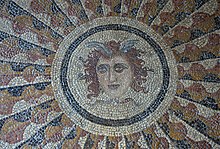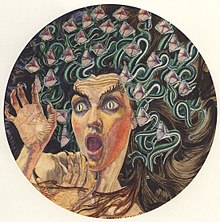
Athena or Athene, often given the epithet Pallas, is an ancient Greek goddess associated with wisdom, warfare, and handicraft who was later syncretized with the Roman goddess Minerva. Athena was regarded as the patron and protectress of various cities across Greece, particularly the city of Athens, from which she most likely received her name. The Parthenon on the Acropolis of Athens is dedicated to her. Her major symbols include owls, olive trees, snakes, and the Gorgoneion. In art, she is generally depicted wearing a helmet and holding a spear.
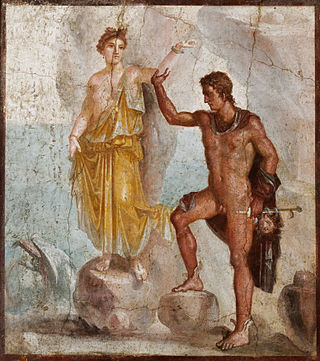
In Greek mythology, Andromeda is the daughter of Cepheus, the king of Aethiopia, and his wife, Cassiopeia. When Cassiopeia boasts that she is more beautiful than the Nereids, Poseidon sends the sea monster Cetus to ravage the coast of Aethiopia as divine punishment. Queen Cassiopeia understands that chaining Andromeda to a rock as a sacrifice is what will appease Poseidon. Perseus finds her as he is coming back from his quest to decapitate Medusa, and brings her back to Greece to marry her and let her reign as his queen. With the head of Medusa he turns Cetus to stone to stop it from terrorizing the coast any longer.
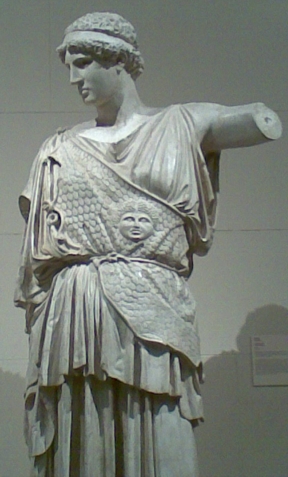
The aegis, as stated in the Iliad, is a device carried by Athena and Zeus, variously interpreted as an animal skin or a shield and sometimes featuring the head of a Gorgon. There may be a connection with a deity named Aex, a daughter of Helios and a nurse of Zeus or alternatively a mistress of Zeus.

In Greek mythology, Chrysaor was the brother of the winged horse Pegasus, often depicted as a young man, the son of Poseidon and Medusa, born when Perseus decapitated the gorgon.
And when Perseus cut off her head, there sprang forth great Chrysaor and the horse Pegasus who is so called because he was born near the springs of Ocean; and that other, because he held a golden blade in his hands.

The Gorgons, in Greek mythology, are three female monsters, Stheno, Euryale, and Medusa, sisters who were able to turn anyone who looked at them to stone. Euryale and Stheno were immortal, but Medusa was not and was slain by the hero Perseus.

In Greek mythology, King Polydectes was the ruler of the island of Seriphos.

In Greek mythology, Perseus is the legendary founder of the Perseid dynasty. He was, alongside Cadmus and Bellerophon, the greatest Greek hero and slayer of monsters before the days of Heracles. He beheaded the Gorgon Medusa for Polydectes and saved Andromeda from the sea monster Cetus. He was the son of Zeus and the mortal Danaë, as well as the half-brother and great-grandfather of Heracles.
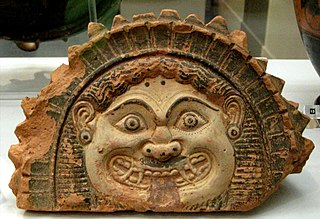
In Greek mythology, Medusa, also called Gorgo or the Gorgon, was one of the three Gorgons. Medusa is generally described as a woman with living snakes in place of hair; her appearance was so hideous that anyone who looked upon her was turned to stone. Medusa and her Gorgon sisters Euryale and Stheno were usually described as daughters of Phorcys and Ceto; of the three, only Medusa was mortal.

Clash of the Titans is a 1981 epic fantasy adventure film directed by Desmond Davis and written by Beverley Cross, loosely based on the Greek myth of Perseus. Starring Harry Hamlin, Judi Bowker, Burgess Meredith, Maggie Smith and Laurence Olivier, the film features the final work of stop-motion visual effects artist Ray Harryhausen.

Two versions of Medusa were created by Michelangelo Merisi da Caravaggio, one in 1596 and the other in ca. 1597. Both depict the moment from Greek mythology in which the Gorgon Medusa is killed by the demigod Perseus, but the Medusas are also self-portraits. Due to its bizarre and intricate design, the painting is said to display Caravaggio's unique fascination with violence and realism. The Medusa was commissioned by the Italian diplomat Francesco Maria del Monte, who planned to gift the commemorative shield to Ferdinando I de' Medici and have it placed in the Medici collection. It is now located in the Uffizi Museum in Florence without signature.

In Ancient Greece, the Gorgoneion was a special apotropaic amulet showing the Gorgon head, used by the Olympian deities Athena and Zeus: both are said to have worn the gorgoneion as a protective pendant, and often are depicted wearing it. It established their descent from earlier deities considered to remain powerful. Among other attributes, it was assumed by rulers of the Hellenistic age as a royal aegis to imply divine birth or protection, as shown, for instance, on the Alexander Mosaic and the Gonzaga Cameo.
The harpē (ἅρπη) was a type of sword or sickle; a sword with a sickle protrusion along one edge near the tip of the blade. The harpe is mentioned in Greek and Roman sources, and almost always in mythological contexts.
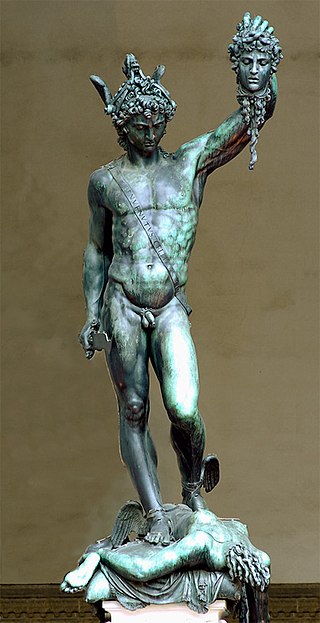
In classical mythology, the Cap of Invisibility is a helmet or cap that can turn the wearer invisible, also known as the Cap of Hades or Helm of Hades. Wearers of the cap in Greek myths include Athena, the goddess of wisdom, the messenger god Hermes, and the hero Perseus. Those wearing the Cap become invisible to other supernatural entities, akin to a cloud of mist sometimes used to remain undetectable.
In Greek mythology, Pallas was one of the Gigantes (Giants), the offspring of Gaia, born from the blood of the castrated Uranus. According to the mythographer Apollodorus, during the Gigantomachy, the cosmic battle of the Giants with the Olympian gods, he was flayed by Athena, who used his skin as a shield.

Petrifaction, or petrification, defined as turning people into solid stone, is a common theme in folklore and mythology, as well as in some works of modern literature. Amos Brown noted that "Fossils are to be found all over the world, a clear evidence to human beings from earliest times that living beings can indeed turn into stone (...) Previous to the modern scientific accounts of how fossils are formed, the idea of magicians or gods turning living creatures into stone seemed completely plausible in terms of these cultures".
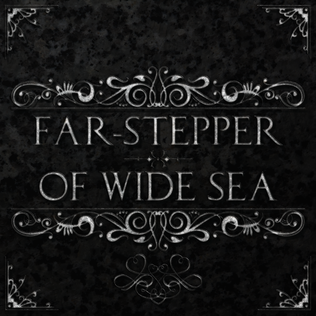
Far-Stepper/Of Wide Sea is the second studio album by British progressive metal artist Returning We Hear the Larks. It was released on 25 June 2013 through Murder on the Dancefloor Records. The album was produced by the project's sole member Jack Noble.
Gorgon is a composition for orchestra by the American composer Christopher Rouse. The work was commissioned by the Rochester Philharmonic Orchestra with support from the Rochester Sesquicentennial Committee to commemorated the one hundred and fiftieth anniversary of the founding of Rochester. It was completed in the summer of 1984 and was first performed in Rochester on November 15, 1984, by the Rochester Philharmonic Orchestra under the direction of David Zinman, to whom the piece is dedicated.
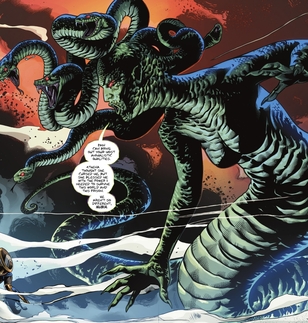
Medusa is a fictional character appearing in DC Comics publications and related media, commonly as a recurring adversary of the superhero Wonder Woman. Based upon the eponymous Greek mythological figure whose story was chronicled in Ovid's Metamorphoses, she is a snake-haired Gorgon with the ability to turn living creatures to stone with her gaze. Since her debut in 1964, Medusa's physical appearance has been presented variously as DC Comics' continuities have shifted and evolved. Though she has routinely been depicted with snakes for hair, she has sometimes been shown as bipedal and sometimes with a serpentine lower body. However across continuities, she has consistently been written with the ghostly ability to possess or influence other beings after her physical body has been killed, as well as an uncanny capacity for resurrection after death. Her characterization has been that of a dangerous immortal creature who is at turns both vengeful and sympathetic.
In Greek mythology, Stheno and Euryale were two of the three Gorgons, along with Medusa, sisters who were able to turn anyone who looked at them to stone. When Perseus beheaded Medusa, the two Gorgons pursued him but were unable to catch him.

